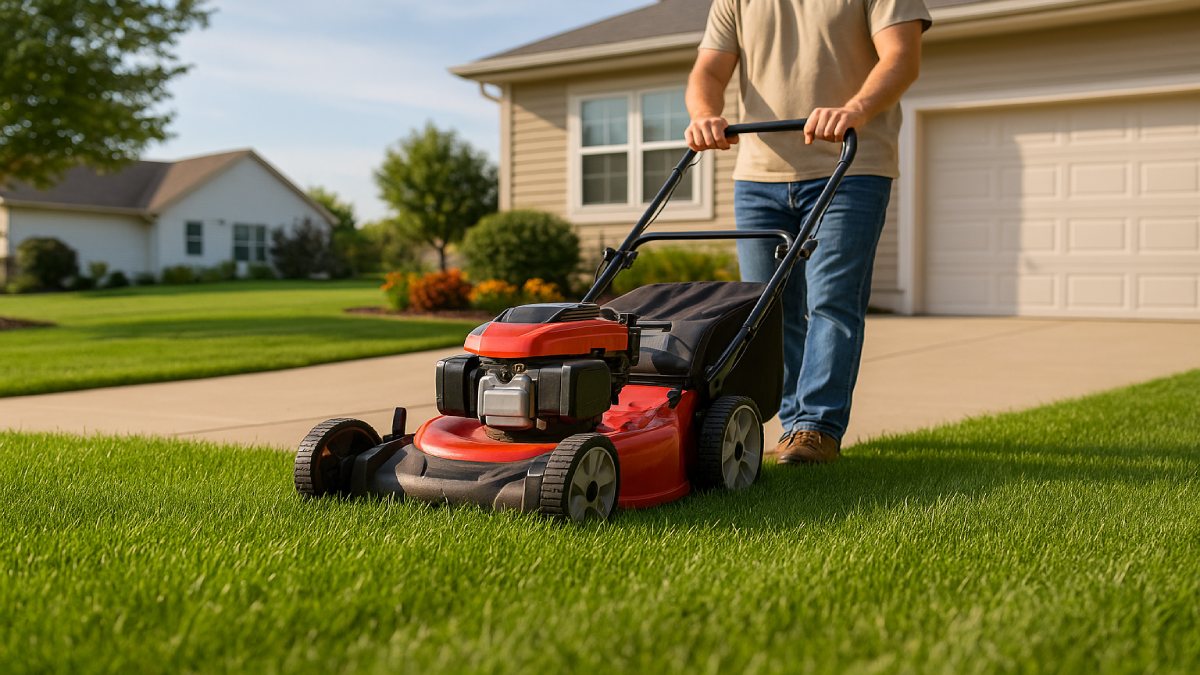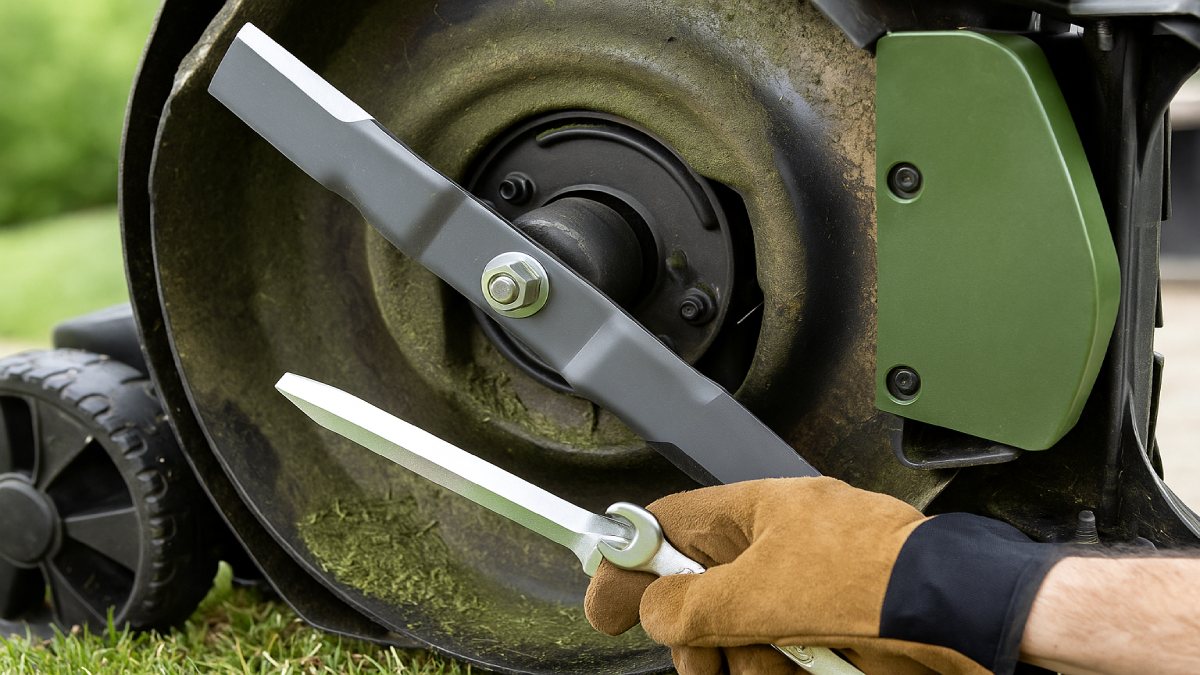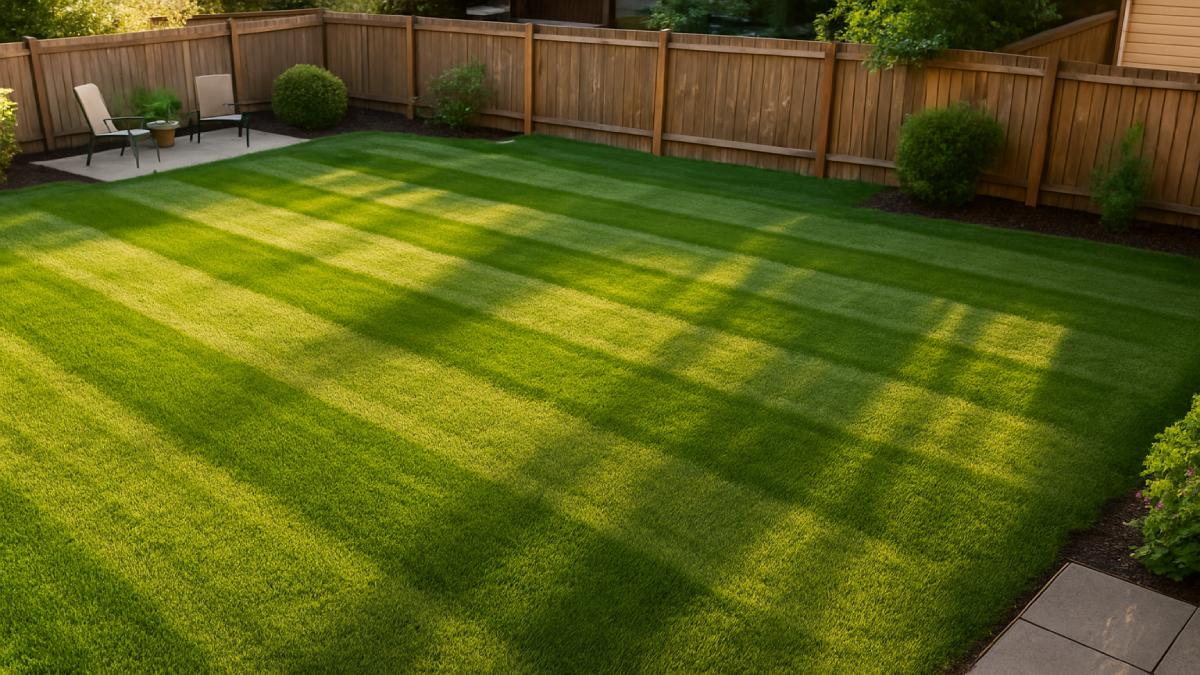Proper Lawn Mowing Tips for a Healthy, All-Season Green Yard
A picture-perfect yard does not start with fertilizer or fancy equipment. It starts with smart mowing habits that match your grass type, climate, and soil. The right cutting height, sharp blades, and a steady schedule all work together to thicken turf, crowd out weeds, and reduce water use. Get these basics right and your lawn looks greener with less effort.
This guide turns expert practices into simple, repeatable steps. You will learn how high to cut cool-season vs. warm-season turf, how often to mow through the year, when to mulch or bag, and how to prevent scalping, stripes that burn in summer, and clumps that smother grass. Keep it handy as a season-by-season playbook you can follow without guesswork.

Why mowing height matters more than you think
Grass makes most of its energy in the upper third of each blade. Cut too low and you remove the engine that powers root growth. Deeper roots reach cooler soil and stored moisture, which keeps color longer through heat spells. A higher cut also shades the soil surface, slowing weed germination and moisture loss. That is why pros repeat the same rule every season: do not remove more than one-third of the blade at a time.
Match height to your grass family
- Cool-season grasses (Kentucky bluegrass, perennial ryegrass, tall fescue): thrive at 2.5–4 inches. The hotter and drier the weather, the higher within that range.
- Warm-season grasses (Bermuda, Zoysia, centipede, St. Augustine): prefer 1–2.5 inches depending on variety. Hybrid Bermudas tolerate the lowest settings; St. Augustine likes it higher.
Not sure what you have? Check blade width, texture, and growth habit. Bluegrass has narrow blades and spreads by rhizomes. Tall fescue has wider blades and bunches. Bermuda forms a dense mat with stolons that creep over the surface.
Dial in your mower setup for clean, even cuts
Sharp, balanced blades slice cleanly. Dull blades tear the tips, turning them brown within a day. Tearing opens a path for disease and dries the leaf faster. Replace or sharpen blades at the start of the season and again mid-season if you mow weekly. After sharpening, always balance the blade to prevent vibration that can damage bearings.
Choose the right deck height step by step
- Measure your current grass height with a ruler from soil surface to blade tip.
- Set your deck so that you remove no more than one-third on the next pass. For example, at 3 inches, cut to 2 inches.
- Recheck on a hard, level surface; deck levers sometimes differ from the printed numbers.
Mulch, bag, or side-discharge?
Mulching returns micronized clippings to the soil, feeding the lawn with slow nitrogen. It also helps keep moisture in the root zone. Bagging is useful when you are reducing height in stages or cleaning up seed heads and weeds. Side-discharge can work when the lawn is very tall; follow with a cleanup pass to spread windrows so the lawn does not smother.

The one-third rule in real life
If storms or travel force a delay, raise the deck to take a lighter cut and plan a second pass three to four days later. This “step-down” method avoids shock. For example, a cool-season lawn that jumped to 5 inches should be trimmed to 3.5–4 inches first, then to 3 inches on the next pass. Keep clippings off walkways and beds to prevent staining and pest harborage.
Seasonal mowing calendar
Spring: wake-up and thicken
Start with a higher cut to protect tender growth. For cool-season lawns, set 3–3.5 inches while soil is moist and temperatures are mild. As growth stabilizes, fine-tune to your target height. For warm-season lawns, hold back heavy scalping; a light trim encourages even green-up without stressing stolons and rhizomes.
Early summer: steady rhythm
Establish a rhythm based on growth—not the calendar. Many lawns need weekly mowing in this period. If you fertilize, growth will surge; be ready to raise deck height during heat waves to reduce stress and to shade crowns.
Peak heat: protect the crown
Higher cutting heights help lawns ride out heat and intermittent drought. Increase cool-season lawns toward 3.5–4 inches. For warm-season turf, ease to the upper end of its range. Mow in late afternoon or early evening once leaf surfaces are dry to limit moisture loss and prevent clumping.
Fall: root building and clean finish
Cool nights and gentle rains drive root growth. Hold a consistent height and mow often enough to avoid heavy leaf litter. If leaves drop, mow with the mulching plug installed to chop them into small pieces that sift into the canopy. This creates organic matter that supports microbial life.
Late fall to first frost
Keep the final few cuts tidy to reduce snow mold risk in cold regions. Do not scalp. Leave enough leaf to photosynthesize on warm days.
Patterns, stripes, and wear management
Alternate directions each mow to keep blades upright. A simple rotation—north/south one week, east/west the next, then diagonal—prevents “grain” from leaning permanently and reduces wheel ruts. For stripes, use a roller attachment or simply overlap passes by a consistent amount. Longer grass bends more dramatically and makes stronger patterns, so striping looks best at higher settings.
Clumping, scalping, and uneven cuts: quick fixes
Clumping in humid weather
- Wait until late morning once dew evaporates.
- Raise the deck one notch for a lighter cut.
- Use a second, perpendicular pass to disperse clumps.
- Clean the underside of the deck; caked grass disrupts airflow.
Scalping high spots
- Walk the lawn and note high crowns or buried roots.
- Raise the deck and slow down; speed amplifies deck bounce.
- Topdress low areas with compost/sand blends to even the surface over time.
Uneven cuts and stragglers
- Sharpen blades and verify both wheels on an axle match the same notch.
- Check tire pressure—low psi makes one side cut shorter.
- Replace bent blades; balancing cannot fix a warped edge.
Mulching vs. bagging: nutrient and pest logic
Clippings do not cause thatch; thatch comes from stems and roots that do not break down. Finely chopped clippings return nitrogen, potassium, and trace minerals to the soil food web. Bagging is useful when removing seed heads from annual grassy weeds, catching heavy debris after storms, or when disease is active and you want to reduce spread. If you bag, consider composting off the lawn to keep nutrients on your property.
Edging, trimming, and the “finished” look
Mowing sets the canvas; edging and trimming frame it. Use a string trimmer to match mower height along fences and around trees. Trim before you mow so the mower lifts and mulches the trimmings. Edge along sidewalks and drives every second or third mow to keep a crisp line. A half-inch bevel is enough—deep trenches invite weeds and crack expansion.

Adapting to drought, rain bursts, and shade
Dry spells
Raise the deck and mow less often. Taller blades shade crowns and slow evaporation. Avoid mowing during peak afternoon heat. If irrigation is available, water deeply and infrequently in early morning; shallow sips encourage weak roots.
After heavy rain
Wait until the soil surface is firm enough to support the mower without leaving tracks. If growth exploded, use the step-down method to return to your target height over two passes. Spread any clumps to avoid yellowing patches.
Shade lanes along fences and trees
In low light, grass grows taller as it searches for sun. Raise height slightly and reduce traffic. Trim tree limbs to bring in more morning light. A thin layer of compost each spring helps shaded lawns form denser turf.
Electric vs. gas mowers and battery strategy
Electric walk-behind mowers are now powerful enough for most urban and suburban yards. They start instantly, run quiet, and need little maintenance. Keep a second battery if your lawn requires more than 45–60 minutes of runtime. For larger properties with tall or coarse warm-season grasses, gas units still offer the torque to clear heavy growth. Keep blades sharp and decks clean on both to maintain proper airflow.
Safety habits you only forget once
- Clear toys, branches, and stones before you start.
- Wear hearing and eye protection; string trimmers fling grit at high speed.
- Never reach under a deck, even when off; blades can spin on stored energy.
- Fuel and charge outdoors or in a ventilated area; wipe spills before mowing.
Fertilizer, growth bursts, and mow timing
Nitrogen fuels leaf growth, which changes mowing frequency. After a feeding, be ready to mow sooner, not lower. Keep height steady. If you overseed in fall, keep the cut high for the first month so seedlings build roots before heavy traffic.
Weed pressure and how mowing helps
Frequent mowing at the right height blunts many weeds. Low, scalped lawns allow light to reach the soil surface, triggering weed seeds. A dense, higher cut blocks that light. For broadleaf weeds that survive mowing, spot-treat on still mornings and keep the deck clean so you do not smear sap across the yard.
Striping without stressing the lawn
Stripes look sharp, yet dark bands can overheat in hot sun if the grass is bent too hard. Keep pattern changes gentle during heat waves. Alternate directions weekly so you do not create permanent grain that resists lifting. If you enjoy bold patterns, do them during spring and fall when grass rebounds faster.
Small yards vs. large properties
On small urban lawns, dial in finesse: sharp blades, frequent light trims, and immaculate edging. For large properties, aim for consistency: wide decks to reduce passes, steady routes that change weekly, and clear staging for clippings and tools so you avoid downtime.

Common mistakes that cost color and thickness
- Cutting too low “to mow less often”: invites weeds and heat stress; the lawn thins within weeks.
- Skipping blade sharpening: causes frayed tips that tan quickly.
- Mowing when wet: compacts soil, tears blades, and leaves clumps that block light.
- Racing: fast ground speed reduces cut quality and leaves mohawks between passes.
- Never changing direction: pushes grass to lean, showing pale tracks and wheel ruts.
Fixing thin spots with a mow-seed-roll routine
- Lower the deck one notch over the spot to expose soil between blades.
- Scratch the soil with a rake for seed contact.
- Spread seed matched to your grass type; blend for sun/shade zones.
- Topdress lightly with compost for moisture and microbe contact.
- Roll or tamp so seeds touch soil; keep evenly moist for two to three weeks.
- Raise the deck back up and mow gently once seedlings reach 3–4 inches.
Edge cases: slopes, ditches, and obstacles
On slopes, mow across the hill with a walk-behind; ride-ons should mow up and down. Use a trimmer for steep sections that feel unsafe. Around trees, leave a grass ring instead of piling mulch against trunks. Trunk flare needs air; mulch volcanoes cause rot and girdling roots.
Simple weekly checklist
- Walk the lawn for sticks, toys, and wet patches.
- Check blade sharpness and deck cleanliness.
- Confirm deck height vs. current grass length.
- Plan your pattern for this mow and note next week’s rotation.
- Mow when the leaf surface is dry and shade is present, if possible.
- Edge and trim for a finished border.
FAQ: quick answers you can rely on
Can I mulch every time?
Yes, as long as clippings are short and disperse evenly. If clumps form, make a cleanup pass or bag once until growth slows.
Is a lower cut safer for pests?
No. Lower cuts dry crowns and invite weed pressure. Healthy, moderately high turf resists pests better and keeps soil cooler.
How do I know my blades are dull?
Within 24 hours, leaf tips look tan and frayed. The mower may vibrate more and leave stragglers. Sharpen or replace right away.
When should I change the mowing pattern?
Every mow. Rotate directions in a three- or four-pattern cycle to prevent grain and ruts.
Put it all together
A lush lawn is the sum of small, consistent habits. Keep the deck high for your turf type, never cut off more than a third, rotate patterns, and mow when leaves are dry. Sharpen blades and keep the deck clean so airflow can do its job. These moves protect the crown, deepen roots, and build a thicker canopy that stands up to heat, boots, and play.
Start with one improvement today—raise the deck, sharpen the blade, or plan your pattern. By next month, the grass will tell you it is working: fewer brown tips, steadier color, and a springy feel underfoot. That is the quiet reward of mowing with purpose.






